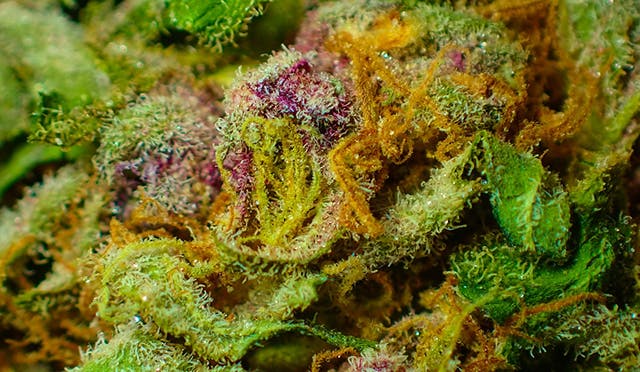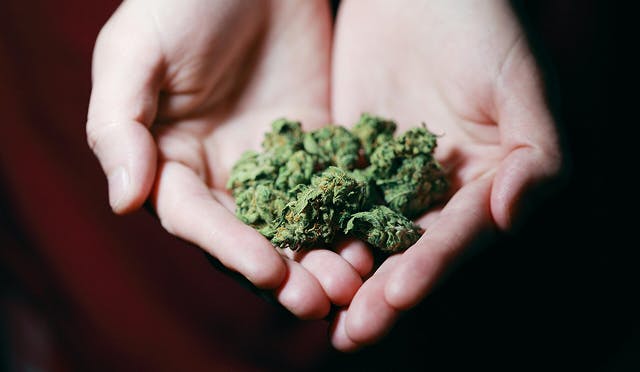Whether you’re new to cannabis or an experienced consumer looking to learn more, here is some basic science to understand how cannabis can help.
The science of cannabis is as complex and intricate as the plant itself. The complexity begins with the more than 50 cannabinoids and terpenoids (two classes of phytochemical active ingredients in cannabis flower) found in the plant. Gaining a better understanding of the science of cannabis and cannabinoids will help you nourish your body and navigate your wellness journey. At Canopy Crossroad we strive to provide an environment of enlightenment and appreciation for the wonders of cannabis.
Identifying the Basics of the Cannabis Plant
Cannabis flower, commonly referred to as bud, weed, or simply flower, is produced from the flower buds of female cannabis plants as the plant grows from vegetative growth to flowering. After being harvested, the flower plant material is dried or freeze dried, processed into a consumption form and then smoked, ingested, or absorbed through the skin or mucosal tissue in the mouth and nose for recreational or medicinal relief.

Different plant genetics make up the cannabis strains we know and love today. Each of these cannabis strains, also known as cultivars, is made up of distinct chemical and flavor profiles that produce a range of psychoactive and non-psychoactive effects. In botany, the term “chemotypes” or chemovar refers to plants that look similar but have unique chemical profiles. A chemotype is a “chemically characterized part of a population of morphologically indistinguishable individuals.”
In an antiquated system of classification, cannabis strains are commonly classified into three categories:
Sativa Cannabis
Depending on the specific plant genetics, cannabis sativa strains are typically known for their higher levels of THC (tetrahydrocannabinol). Many sativa strains are notorious for their uplifting and energizing effects, especially compared to other forms of cannabis.
Indica Cannabis
While these strains vary in their specific effects, most indica strains are known to induce relaxation and sedation, with some holding higher levels of CBD than THC for more calming effects.
Hybrid Cannabis
The specific profile of all hybrid strains greatly depends on the dominant genetics, cannabinoids, and terpenes that make up the strain. Some hybrid strains may have more relaxing and peaceful effects, while other hybrids may leave you feeling a buzzing energized high.
Chemotypes
A more modern approach to classification is to organize strains into chemotype, based on chemical analysis of the cannabinoids and terpenes. In this approach, strains are classified into Type 1: THC dominant, Type 2: balance THC:CBD ratio and Type 3: CDB dominant with lower concentration of THC. In addition, chemotypes can then be thought of as having a dominate feeling, ie sleepy, vs creative.
Step into our Red Bank recreational cannabis dispensary and chat with our friendly budtenders about the preferences and desired high you’re looking for. Our expert team of budtenders is here to help determine the best cannabis strain for you.
What is the Endocannabinoid System (ECS)?

The Endocannabinoid System (ECS) plays a vital role in maintaining homeostasis, meaning the regulation of balance within the body. Intricate in the human body, the endocannabinoid system is made up of receptors, enzymes, and indigenous endocannabinoids that all contribute to a wide range of physiological processes – including the immune, nervous, and digestive systems.
Considering the many touchpoints the ECS has throughout our bodies, this system greatly contributes to our overall well-being and health.
There are two key receptors in the ECS, CB1 and CB2.
- CB1 (Cannabinoid 1) receptors are primarily found in the brain, spinal cord, and central nervous system. They influence functions like mood, memory, and pain.
- CB2 (Cannabinoid 2) receptors are sparsely abundant in immune cells and peripheral tissues, which play a significant role in modulating immune responses.
- Both of these receptors act like gatekeepers that receive signals from endocannabinoids, working to regulate various bodily functions and respond to the body’s needs at that given moment.
Overall, the ECS and its receptors work like a symphony conductor, orchestrating a harmonious balance within the body’s many systems and responses. By understanding how the ECS functions, research continues to discover ways cannabis can symbiotically work with our endocannabinoid system to improve overall well-being.
What are some benefits and effects of cannabis?

As the legalization of recreational cannabis in New Jersey emerges, many studies are suggesting the many therapeutic benefits and effects cannabis offers.
- Pain Management: THC and CBD are the two major compounds effective in addressing pain relief because of how they interact with our endocannabinoid system. This interaction can make cannabis useful for managing chronic pain or nausea.
- Stress Relief: Particularly with strains higher in CBD and lower in THC, cannabis can help ease tense feelings of stress. Because CBD is known for its calming effects, you’ll often find CBD-based cannabis products at our NJ dispensary promote a better sense of relaxation.
- Better Sleep: Known to also influence sleep patterns, certain cannabis strains dominant in more sedative terpenes and micro-cannabinoids can help those who have trouble falling or staying asleep.
While these benefits of cannabis barely scratch the surface of all this complex plant holds, it’s important to note that many common effects of cannabis consumption may vary from person to person.
Why Cannabinoids & Terpenes are the Key Players in Cannabis

Cannabis is made up of thousands of chemical and plant compounds, known as cannabinoids – some of which remain unknown or not fully understood by scientists today. However, with the cannabis compounds that we have gained more insight about in recent years, it is important to understand the effects and benefits of each to optimize your experience.
THC (Tetrahydrocannabinol)
Considered the most popular and well-known cannabinoid today, THC is directly responsible for the psychoactive high feeling experienced with cannabis. It’s a cannabinoid that binds with the receptors in the endocannabinoid system to stimulate neurons and release the chemical dopamine in the brain.
CBD (Cannabidiol)
As a non-psychoactive cannabinoid, CBD still has become widely popular at Canopy Crossroad’s NJ dispensary for its incredible wellness benefits. CBD interacts with our endocannabinoid system to signal relief to pain, anxiety, and various other symptoms in our bodies.
Alternative Cannabinoids
While both CBD and THC are the main superstars you’ll find at our recreational dispensary in NJ, we also carry many cannabinoid-based products that target more specific effects and therapeutic benefits.
For instance, CBN is a cannabinoid present in most cannabis cultivars, although the content increases the longer the flower has aged or degraded. Its effects give a more mild and sedative feel than other cannabinoids, which is why it’s commonly found in sleep-related cannabis products.
Additionally, CBG is an alternative cannabinoid that has been found to have similar therapeutic benefits as CBD, including antibacterial properties.
Terpenes
Terpenes are naturally occurring aromatic compounds that are present in most plants, including cannabis. These compounds are responsible for the distinctive taste and aroma of different cannabis strains. In addition to providing a unique flavor profile to cannabis flowers, terpenes also play a crucial role in determining the effects that a particular strain will have when consumed.
Curious to explore the abundance of cannabinoids, terpenes, and compounds that compose the cannabis plant? The team of budtenders at our women-owned Red Bank cannabis dispensary is here to answer your canna-curious questions and help you explore the many options of cannabis.
Curious to explore the abundance of cannabinoids, terpenes, and compounds that compose the cannabis plant? The team of budtenders at our women-owned Red Bank cannabis dispensary is here to answer your canna-curious questions and help you explore the many options of cannabis.
Tips for Cannabis Consumption

Especially in today’s innovative cannabis industry, there are many ways to consume cannabis. Depending on the specific method or mode of consumption, cannabis and its effects may be absorbed in your bloodstream or metabolized differently.
Be sure to understand the estimated onset and duration of effects based on your method of consumption and cannabis dosage.
A few of the most common methods or modes of cannabis consumption include:
- Flower and cannabis concentrates/vape oil cartridges – Smoked in pipe, bong, joint, etc or vaporized (temperature below combustion where cannabinoids and terpenes vaporize into gas phase)
- Oral or Edibles – including gummies, chocolates, infused beverages and snacks (Oral Tinctures – added to drinks or Oral Capsules & pills)
- Topicals – Oil applied to skin
- Sublingual and Buccal – wafers, films or suckers placed in mouth under tongue dissolves and metabolized via mouth absorption.
Whether you’re a newbie to cannabis or exploring a new product for the first time, be sure to start slow and low with your dosage – no matter the method of consumption! This will ensure you can identify and assess the affects you feel, without getting overwhelmingly too high on accident in the process.
Featured post

Sweet Dreams Are Made of Weed
In our fast-paced world, getting a good night’s sleep can sometimes feel unattainable. We’ve all had...

June Newsletter

March Newsletter
When you sign up for the Canopy Club, you become part of our growing community — and with that comes...

How to Buy Adult-Use Cannabis in New Jersey
Since recreational cannabis became legalized in New Jersey, there have been many exciting advancemen...

The Science of Cannabis for Beginners
The science of cannabis is as complex and intricate as the plant itself. The complexity begins with ...


